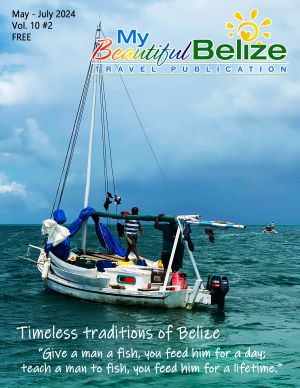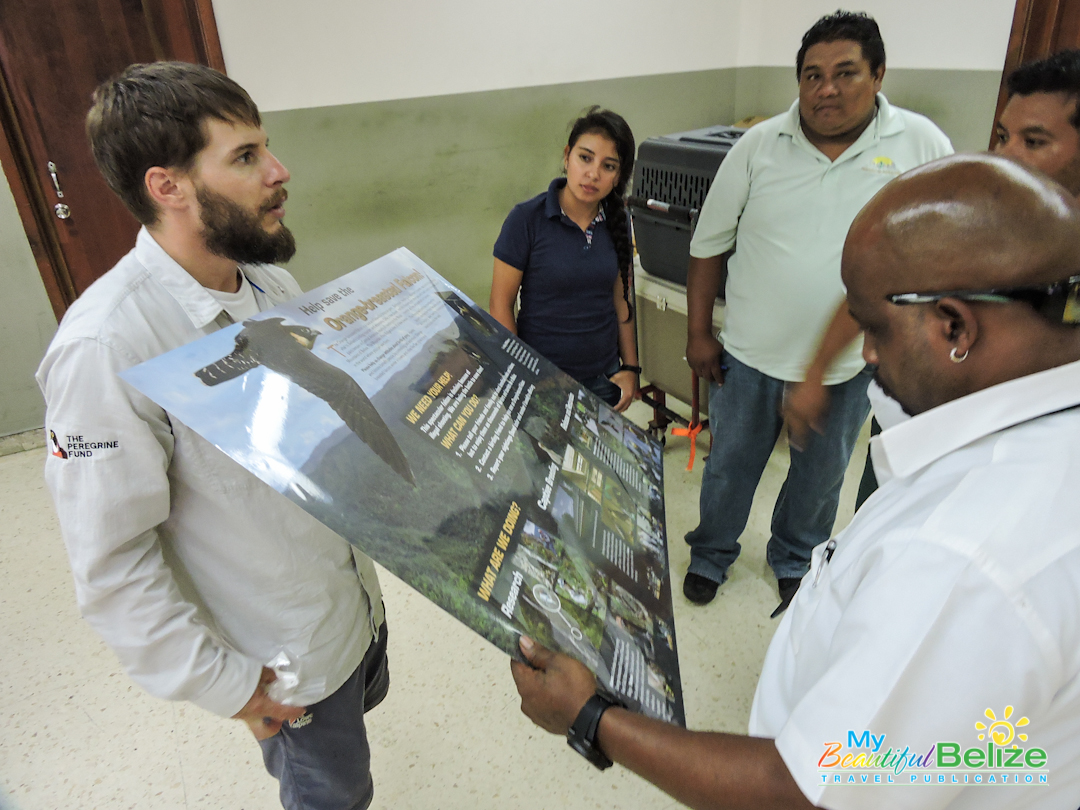 There was a commotion at the Customs and Immigration area at Philip S.W. Goldson’s International Airport in Ladyville, Belize. Huddled around a large pet carrier, uniformed officials, along with a few baggage handlers and I peered into the crate…and blinking back were four, wide-eyed white fuzzballs with large beaks.
There was a commotion at the Customs and Immigration area at Philip S.W. Goldson’s International Airport in Ladyville, Belize. Huddled around a large pet carrier, uniformed officials, along with a few baggage handlers and I peered into the crate…and blinking back were four, wide-eyed white fuzzballs with large beaks.
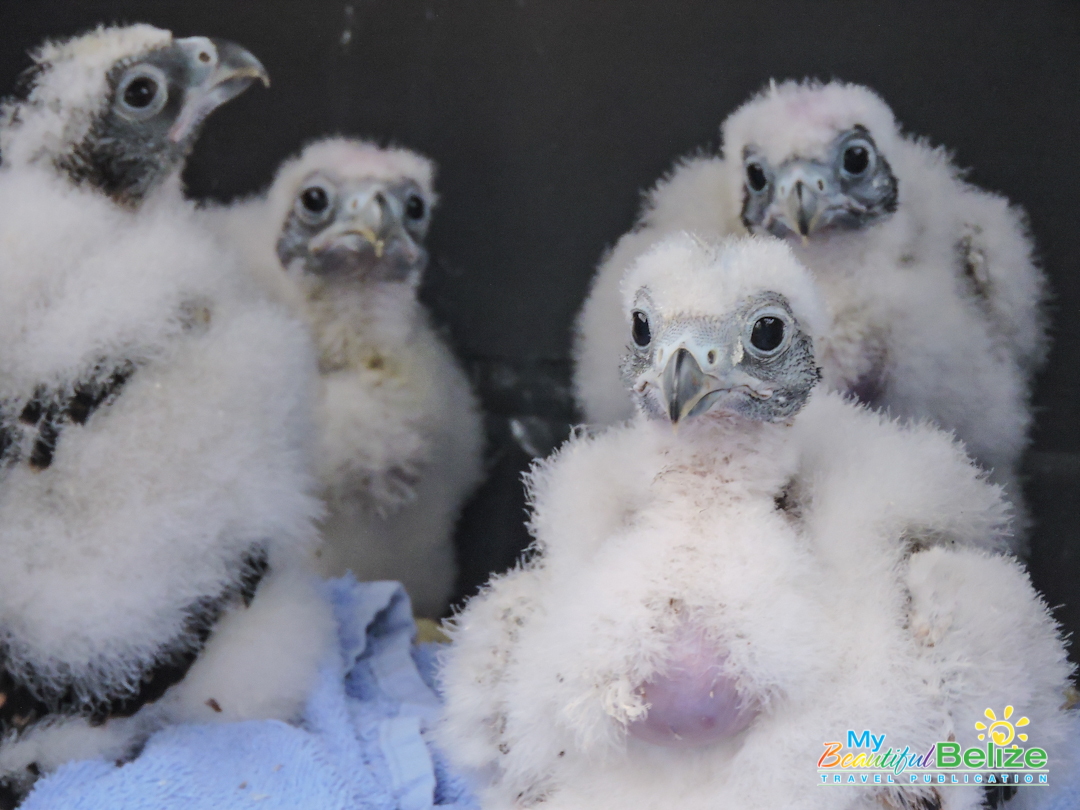
No, this wasn’t an alien invasion; the adorably kooky looking chicks were the VIP’s of the esteemed Orange-breasted Falcon (OBF) team of biologists and researchers who have been surveying and color-banding OBF’s in Belize since 1992. In an unprecedented effort to save this endangered species, the program has been introducing captive-bred OBF’s into their wild habitat in the Maya Mountains of western Belize for the last ten years.
As a Wyoming gal, I’ve been a raptor lover for years. There’s something synonymous with the wild west; expansive clear blue skies accented with a soaring broad-winged bird, and the classic ping of the Red-Tailed Hawk. My love for raptors followed me to Belize many years ago, and I first learned of the Orange-breasted Falcon when I spotted a Bat Falcon while exploring the Tikal Archeological Site in Guatemala in 2002. My guide explained that often the Bat Falcon is mistaken for the much larger and rarer Orange-breasted Falcon; I was intrigued…tell me more! Over the years I’ve studied up on these falcons, in awe of their stunning beauty and deeply concerned about their imperiled existence.  You can imagine my surprise when I discovered that the only Orange-breasted Falcon captive-breeding program in the world was in Wyoming, of all places! I knew then and there I was the connection for sharing the amazing story of the Peregrine Fund and their efforts to save the declining OBF population in Belize. Like a dream come true, there I was, after years of planning, staring wide-eyed and blinking back at some of the rarest bird babies in the world, and finally meeting Mr. Robert Berry, the “foster daddy” of them all.
You can imagine my surprise when I discovered that the only Orange-breasted Falcon captive-breeding program in the world was in Wyoming, of all places! I knew then and there I was the connection for sharing the amazing story of the Peregrine Fund and their efforts to save the declining OBF population in Belize. Like a dream come true, there I was, after years of planning, staring wide-eyed and blinking back at some of the rarest bird babies in the world, and finally meeting Mr. Robert Berry, the “foster daddy” of them all.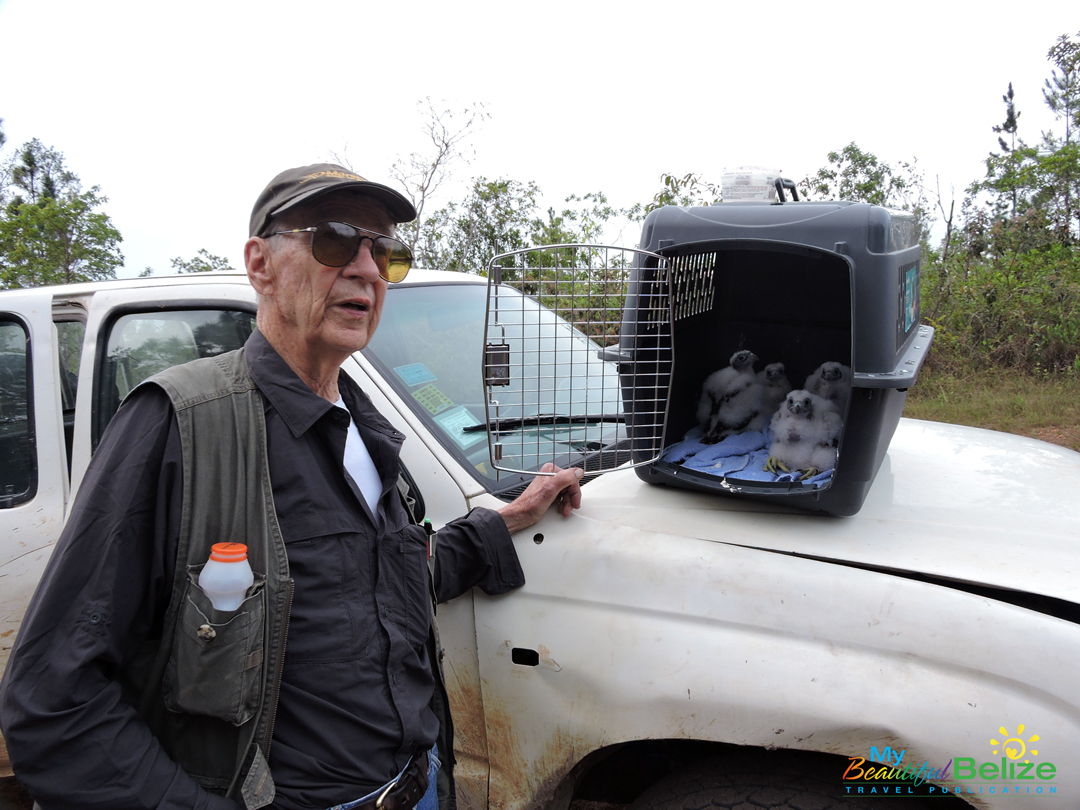
The pieces came together when I meet skilled local birder Jonathan Urbina in 2014 while birding with the Belize Audubon Society, and learned that at the time he was working with the OBF program. I begged to connect with his boss and founder of the Orange-breasted Falcon Project and captive breeding program Mr. Berry.
Not only was I was determined to write about their valiant efforts to restore an endangered species, but selfishly, my agenda included the fact that I’d yet to see one of these spectacular falcons, which topped my birding bucket list! The dialogue of covering the story went on for years, until June 2017 when Matt Allshouse, Lead Field Biologist for the Belize OBF project and I could coordinate our plans.
Matt, who has worked with the OBF program since 2011 and lives in my hometown of Laramie, (love that Wyoming connection), invited me to join them when they were bringing captive-bred chicks to Belize for release. It all started with meeting them at the international airport where I would accompany them to the Cayo District and witness the amazing process of introducing these juveniles to the wild.
In mid-June, when the captive-bred chicks are about 40 days old they are flown to Belize, often by a donated private charter, as the chicks are too delicate for safe passage on commercial airlines. It’s a 12-hour travel day for Bob, who raises the birds, with a stop in Houston, Texas for a thorough vetting of the many permits required to transport the precious cargo. Once they arrive in Belize, armed with stacks of documents and 400 pounds of laboratory-raised frozen quail to feed the juveniles for the next few months, Matt and Bob are prepared for a less than routine customs inspection from the Belize Agricultural Health Authority. 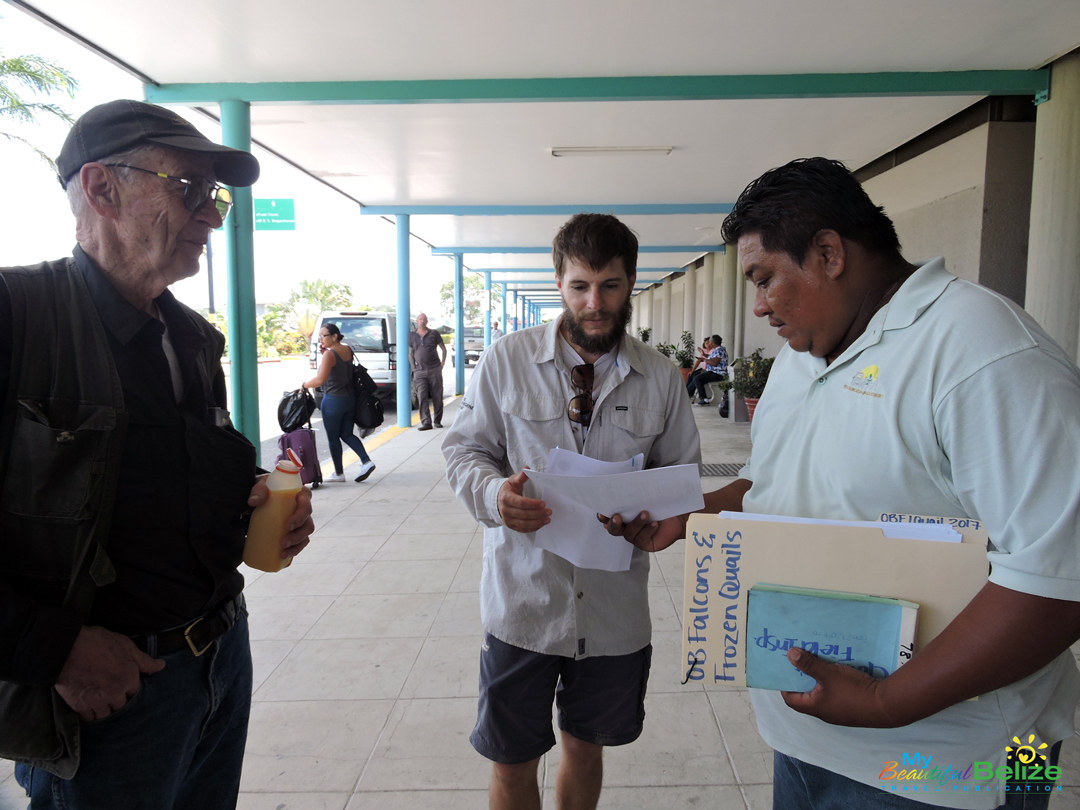 It’s a painstaking but essential process with multiple biological and health test results examined and duplicated in both the US and Belize to make certain that no diseases are imported. It’s an exciting but stressful day for the OBF team who have worked tirelessly in preparation for months. I’m thrilled to be a part of it and from the airport, I follow the team on a three-hour drive to a remote area in the Mountain Pine Ridge area where we stay the night and prepare for the next big day.
It’s a painstaking but essential process with multiple biological and health test results examined and duplicated in both the US and Belize to make certain that no diseases are imported. It’s an exciting but stressful day for the OBF team who have worked tirelessly in preparation for months. I’m thrilled to be a part of it and from the airport, I follow the team on a three-hour drive to a remote area in the Mountain Pine Ridge area where we stay the night and prepare for the next big day.

I might not be a bonafide biologist, but I love hanging out with wildlife rock stars. We speak the same language, our common denominator a pure passion for protecting species that have been exploited to the verge of extinction. The OBF team of biologists and researchers are no different, I just need to learn the lingo! At first, their conversations sound like a combination of algebra, colors and alphabet soup when they refer to B1, Orange 47, Purple 29 and Caya, the equations a complex formula to permanently identify age, sex and origin. It’s fascinating to learn that captive bred females carry red bands, males blue, while wild-hatched females have orange bands and males purple. The bands, fitted around what a novice like me would call an ankle, have bold white numbers that can usually be seen with a scope or binoculars. These bands help decipher reports to eBird which many birders in Belize are now doing, and the OBF team encourages people to report all sighting which is relatively common in towns and cities during the Fall and winter months, where the OBF feeds on feral pigeons and collared doves.
It feels like we are on a covert operation when at the crack of dawn the following morning we are four-wheeling on rough and windy roads through dense forest and locked gates to the hack site where the chicks will begin their new life. Sadly, due to the black-market demand for these beautiful falcons in the Middle-East, there is good reason for our discretion. The hack site (falconry vernacular for surrogate nest) is located at a remote location and consists of a two-story wooden tower situated on a mountain top surrounded on three sides by steep canyons that provide ample escape routes from avian predators when the youngsters begin to fly. Adjacent to the tower is a screened hut called the Pavilion (a metaphoric exaggeration) where hack site attendants, aka research and graduate students, escape the black flies while caring for the young falcons during daylight hours.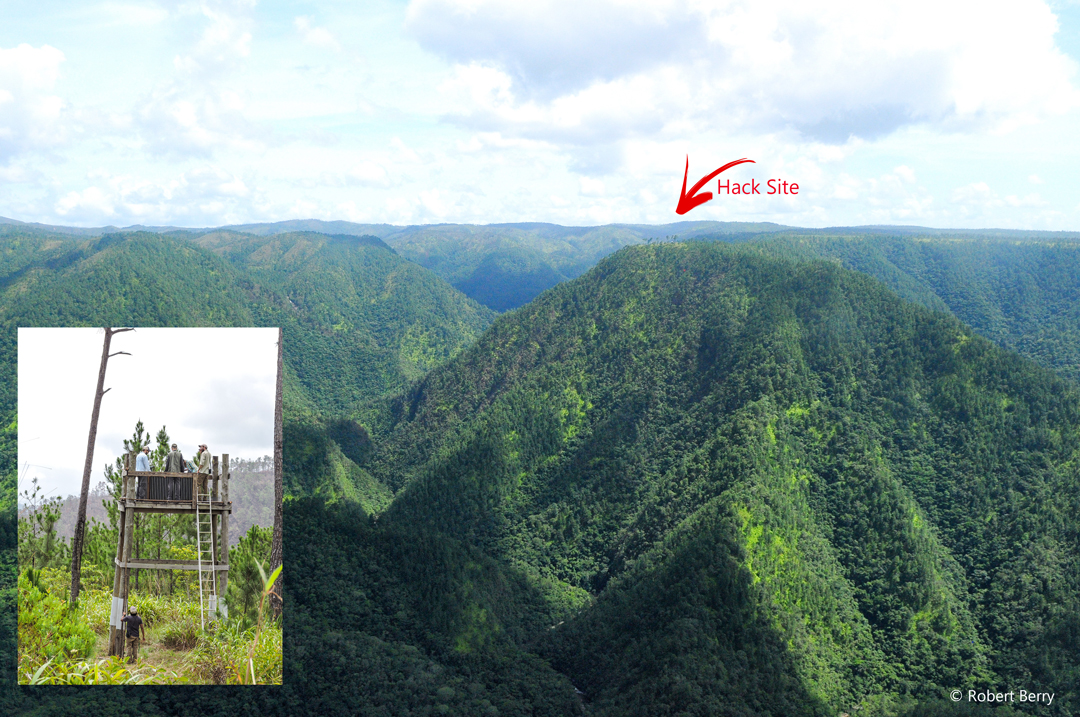
While I ooh and aah over the chicks-in-waiting (three females and one male) the team scales a wobbly extension ladder to prepare the hack site, making sure the platform is secure, provides ample protection and perches. I’m so engaged in baby-bird-admiration that I don’t notice that a nest box is situated high in a nearby pine tree, and am completely surprised when an Orange-breasted Falcon swoops down to check us out. It’s one of those moments, like when I first saw Scarlet Macaws in the Chiquibul Forest, or hundreds of Pink Flamingos in Celestun, Mexico, or spotted a first-ever-recorded Swainson’s Hawk on Ambergris Caye…no words, just slack-jawed astonishment.

I like to think of Orange-breasted Falcons as smartly dressed super-heroes of the neotropical rainforest. Tailored with a black mask and hood, their back is cloaked in dusky black with feathers trimmed in blue-gray. Their pure white throat brightly contrasts with a broad band of orange-rufous across the upper breast and a coarsely patterned black vest that reminds me of mithril (aka chain-mail) from the Lord of the Rings, that adorns their lower belly, flanks, and undertail. Arguably the most beautiful of falcon species, these compact aviators prey on a wide variety of small to medium-sized birds and bats and are streamlined for high-speed dives, being the only raptor species capable of making a living hunting above the forest canopy.
I love that the female Orange-breasted Falcon is the envy of all falcons when it comes to being armed! Relative to her body size, this tough mama’s arsenal comes with an unusually large beak, the largest feet of any falcon, and thick powerful legs that make her a force to be reckoned with when she’s on the defense. Males have the same plumage characteristics but are half the size of their mates with normal falcon armature. Always rare and widely distributed in Central and South America, these gorgeous raptors are now absent throughout Central America with less than 20 territorial pairs remaining in Belize and Guatemala and only four pairs accounted for in Panama.
Although many countries in the area contain seemingly suitable habitat, it is a mystery why they have disappeared. The declining core population in Belize is now limited to the Mountain Pine Ridge and nearby areas, with a few pairs in the southern Maya Mountains. A low reproductive rate (compared to other raptors) along with human conflicts such as loss of habitat (clear-cutting), fragmentation, shooting, collisions with high-tension wires, and electrocution from power poles as well as natural predation and parasites are thought to be responsible. In 2012 the International Union for Conservation of Nature (IUCN) up-listed the Orange-breasted Falcon to Near Threatened based on The Peregrine Fund’s research. The Fund’s core study population of 12 breeding pairs in the Mountain Pine Ridge area declined to five wild pairs in 2016. If trends continue extinction is not far off, something the OBF team is committed to preventing. To see an OBF in the wild is a rare and breathtaking sight, to have the opportunity to witness the efforts to sustain this imperiled beauty…extraordinary.
Once the team situates the chicks in their new home with a stunning view, they will roost there for the next four months while learning how to be a responsible adult and fend for themselves. Sure, they now have a spectacular home, but I keep wondering, how will they learn to be wild?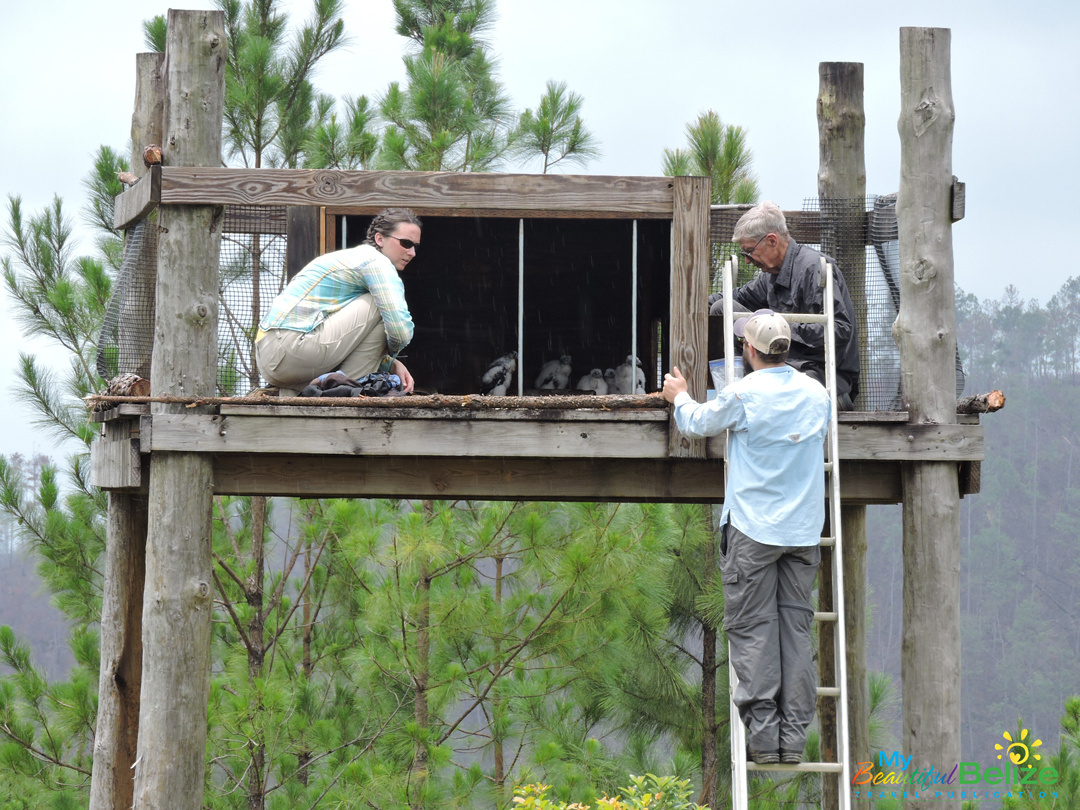
I am surprised when Matt straps on a helmet and prepares to ascend the nearby tree that houses the nest box! Obviously, the OBF we spotted is the very protective mama of whatever is in that nest box (remember what I said about the females being well equipped for battle) and she attacks viciously, dipping and diving in protest. Bob, a very spry octogenarian, scampers up the tree behind Matt as he retrieves a single chick from the nest (three is their maximum).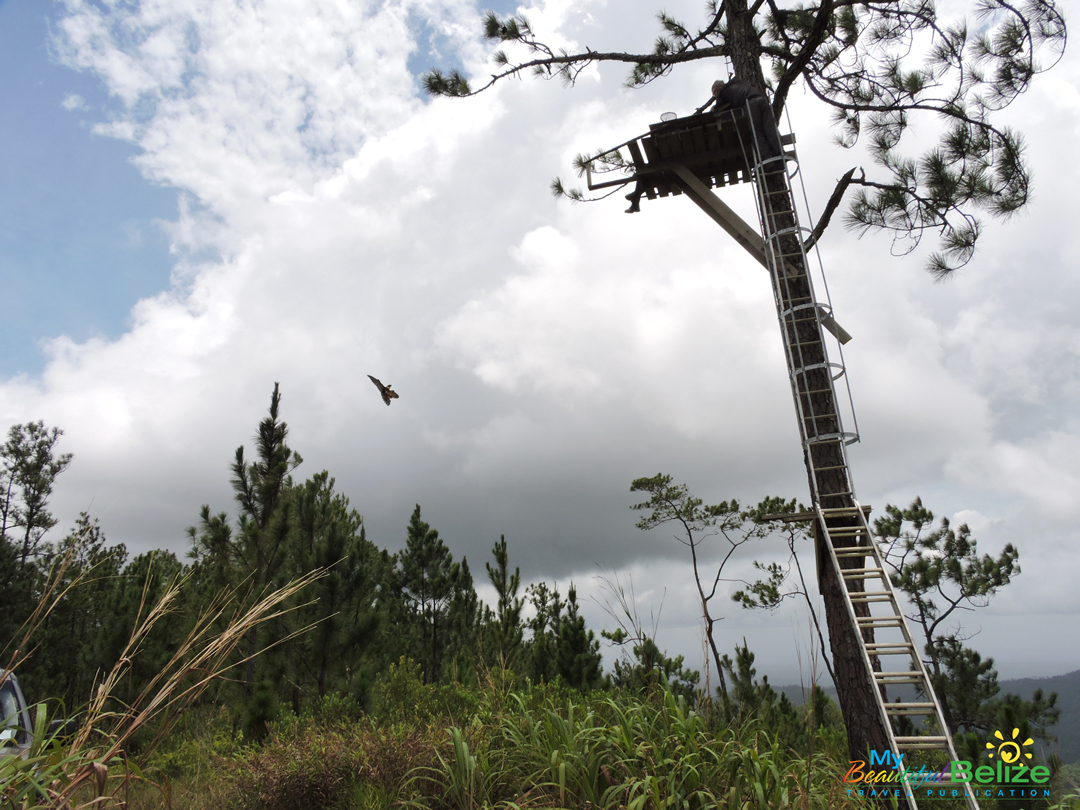
The mama, known as Orange 47 and originally banded in 2015 by the team in Tikal, aggressively nails Matt on the shoulder, her razor-sharp talons ripping his shirt. She then snatches Bob’s ball cap right off his head, taking a small portion of his scalp with it! Up she flies, dropping, then retrieving the cap in an attempt to kill it as it falls into the deep canyon, her aerial assault lightning fast. I’m impressed when the experienced team reacts with amazing calm!
The chick-nabbers retreat from the tree, where inside the Pavilion the baby is weighed, given a health assessment, banded and blood-feathers collected for genetic testing. Team member Audrey Martin, who is conducting next-generation genetic sequencing for her master’s degree at the University of Wyoming, (yet another Wyoming connection), will use this important data in her research. The wild chick (a male) is then carefully placed with the four captive-bred babies on the hack platform. I can’t help but wonder how the introductions went, the clutch of captive-bred chicks huddled in one corner, clearly checking out the new chick on the block.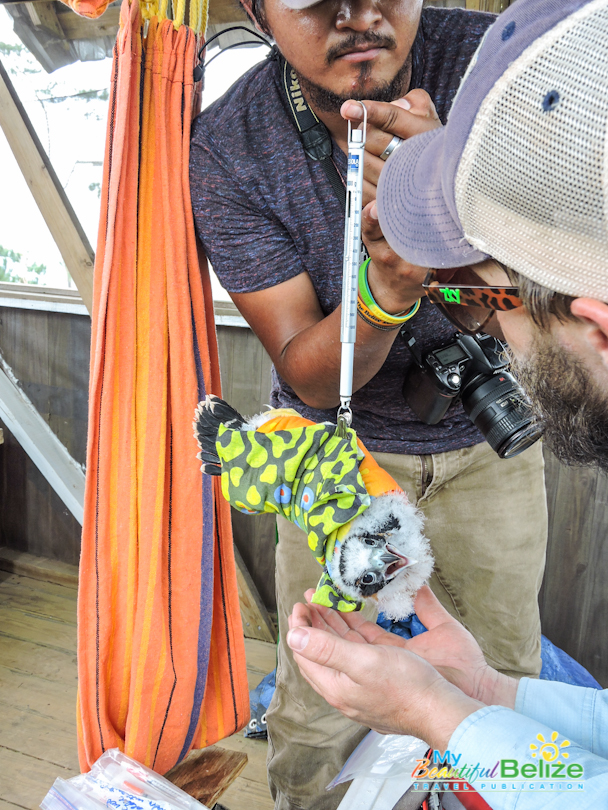
I was familiar with the practice of placing captive-bred birds into wild nests when assisting threatened species, but doing it the other way around seemed unprecedented. According to Bob, falconers in the middle-ages developed the hacking process, fledging their falcons from artificial enclosures, similar to the hack tower, an innovative technique now used to repopulate endangered raptors such as Peregrine Falcons, and now for the first time Orange-breasted Falcons! Combining the wild chick from the nest box with the captive-raised chicks enables all the chicks to be raised by wild parents to avoid imprinting on the human attendants. Amazingly, the parent(s) of the wild chick will respond to the hunger-begs of their transplanted baby and soon will not only start feeding their off-spring but the captive-bred chicks as well! Regretfully, Orange 47 became a single parent the day before we arrived, her mate B1, a captive-bred falcon hacked in 2010 and known to father seven wild offspring, including the one just added to the hack site, disappeared and is presumed dead.
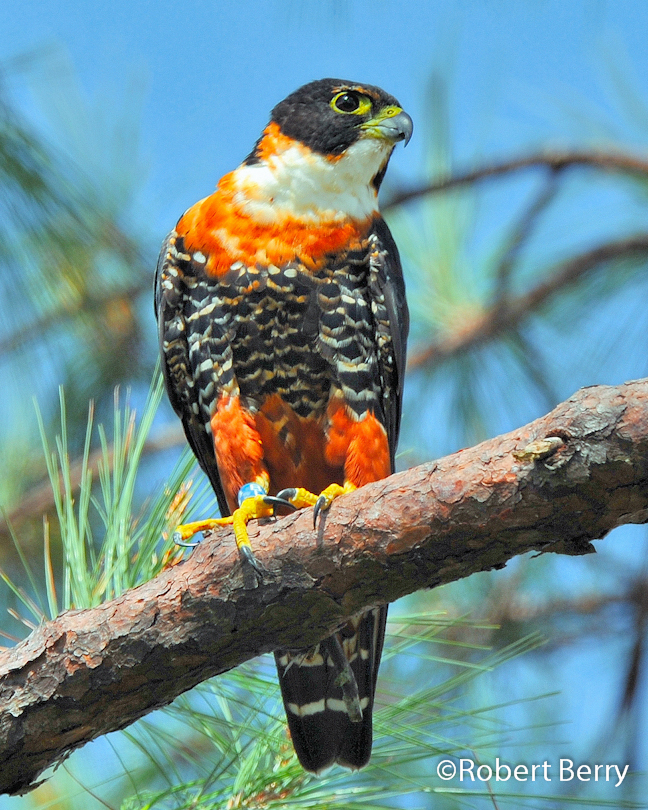
The single chick would likely have starved as the male does most of the hunting, transferring the food to the protective female to feed the chicks. Of course, suddenly having to feed a family of five is too much to ask of any parent, and for the next few months, the hack site attendants will supplement their meals with tasty frozen quail, taking care to avoid habituating the chicks to humans. It doesn’t take long for these surrogate parents to identify and bond with each falcon through its unique vocalizations, wing beat, appearance, and personality, which they seem to have plenty of!
As much as I want to swap jobs with one of the hack attendants I am forced to return to the reality of work, although I promised to return in August when the juveniles are all but finished with hack site life. There only a day to witness this amazing adoption process, it is all I can do not to text message Matt three times a day once I reach home on Ambergris Caye. “I know Orange 47 was perched protectively near to the hack site when I left, did she come to the chicks yet,” I message. “Not yet, she’s in the box next to the tree,” he responds. “We haven’t fed the chicks today in hopes their food-begs will attract her!” Everyone is super bummed about the disappearance of B1, and Matt adds, “B1 has not come back, but today had a wild bird I banded last year at 1,000 Foot Falls showed up for the first time (Purple 21).” A week later Matt sends me a photo from the hack site and I am surprised at the change in the chick’s appearance. These ‘ugly ducklings’ are morphing into beautiful colors and distinct markings. 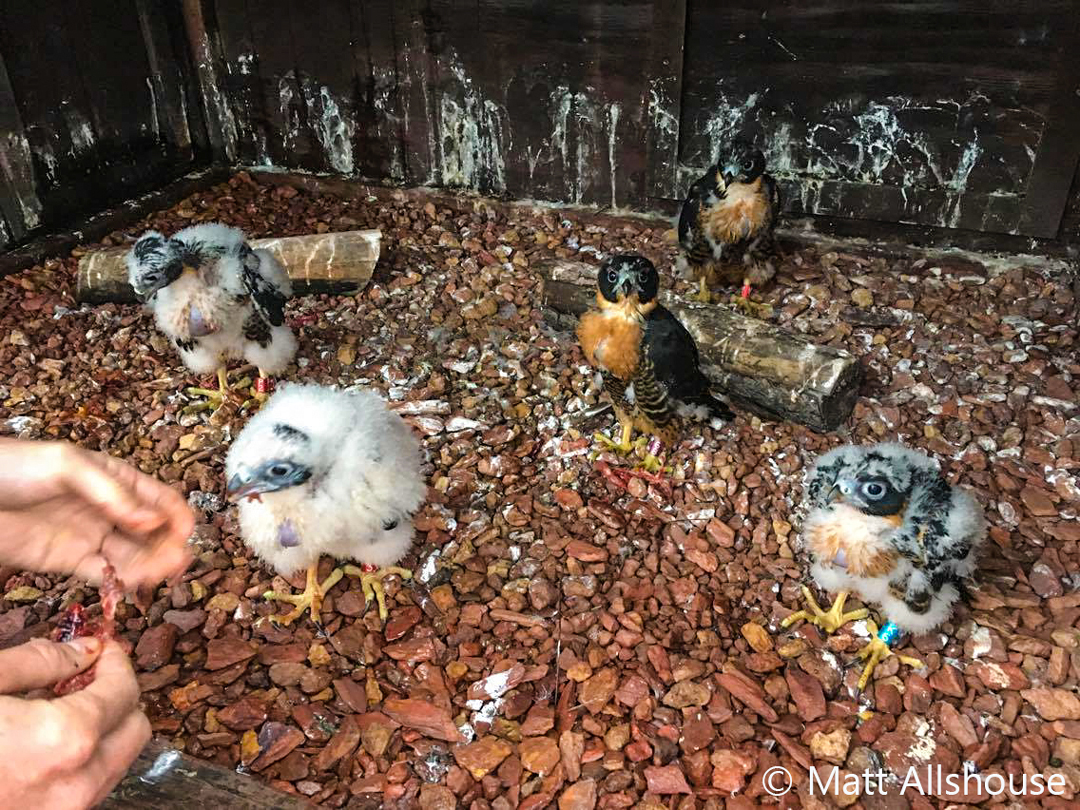 Matt is also happy to report that Orange 47 is feeding all five of the babies, and now another male, Purple 29, who happens to be B1’s two-year-old son has now pair-bonded with Orange 47 and is sharing the hunting responsibilities. The team is ecstatic that one of B1’s progeny is now the resident male at the hack site, a bittersweet outcome that points out how few available bachelors are out there, especially in the remaining epicenter of the local OBF population. It won’t be long before these juveniles will attempt their first flights in their journey into adulthood and the dangerous world.
Matt is also happy to report that Orange 47 is feeding all five of the babies, and now another male, Purple 29, who happens to be B1’s two-year-old son has now pair-bonded with Orange 47 and is sharing the hunting responsibilities. The team is ecstatic that one of B1’s progeny is now the resident male at the hack site, a bittersweet outcome that points out how few available bachelors are out there, especially in the remaining epicenter of the local OBF population. It won’t be long before these juveniles will attempt their first flights in their journey into adulthood and the dangerous world.

In early August I get to spend an afternoon with Matt back at the hack site. The area is beautiful, and even though things are pretty quiet, it’s still a great place to hang out. Matt reports that one of the captive-bred females has not returned to the site for several days. Although it’s hard not to worry about these young birds, the team stays optimistic that she is busy staking out new territory somewhere else. The others occasionally return for a free lunch but show evidence that they’ve adapted well to life in the wild, especially hunting and feeding themselves.
According to Bob, who directs the project, the 2017 hack was successful with three unrelated juveniles reaching independence and probably a fourth that dispersed earlier. They estimate that the nine surveyed breeding pairs in Belize, including the hack site pair, may have fledged as many as 15 young this year, eleven in the wild and four captive-bred. Mortality is very great and based on experience at the hack site, even with care from both wild parents and attendants, they have found that a third of these fledglings perish prior to independence in the Fall. Over the last ten years, the OBF program has released 52 captive-bred chicks into the Mountain Pine Ridge area. Bob believes that by working with a small, viable wild population, their modest successes has been crucial for the species with a total of 10 young falcons produced in the wild with a captive bred adult, adding unrelated genes from Panama to an inbred population that should increase fitness and productivity. He reiterates that education and conservation efforts by local groups, eco-lodges, government agencies, and individuals all help to create an awareness and give meaning to the vital role raptors play in the web of life, along with their practical benefits in pest control and eco-tourist dollars that depend upon a healthy ecosystem.
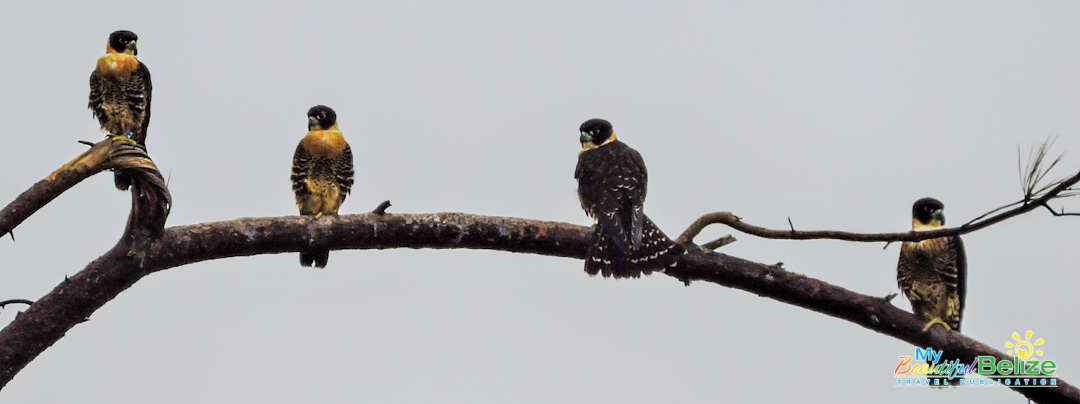 As we four-wheel out of the hack site area on my last day there, Matt spots something he has never seen before. Perched on a tree limb above the road sit all four falcons. He’s amazed that they really do hang out together after leaving the hack site, and I am blessed with a beautiful parting photo. It’s the perfect farewell from my gorgeous falcons and an image I’ll never forget.
As we four-wheel out of the hack site area on my last day there, Matt spots something he has never seen before. Perched on a tree limb above the road sit all four falcons. He’s amazed that they really do hang out together after leaving the hack site, and I am blessed with a beautiful parting photo. It’s the perfect farewell from my gorgeous falcons and an image I’ll never forget.
If you would like to learn more about this project and how you can help, please visit http:/www.bit.ly/OBFalcon. For identification assistance (OBF versus Bat Falcon) you can visit www.birds.cornell.edu/obf



